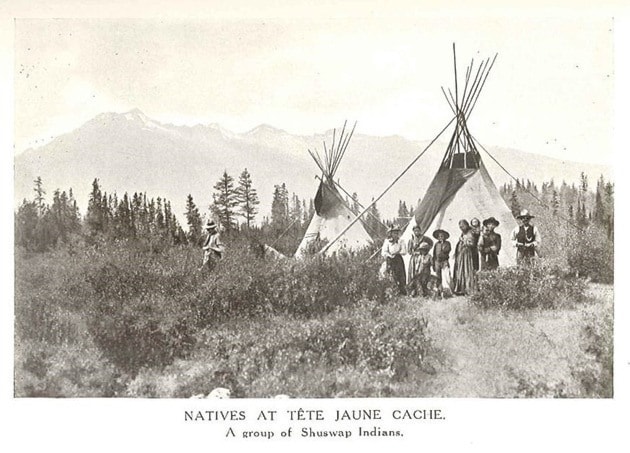Celia Nord
One hundred years ago, in August 1916, a large group of Simpcw people was forced against their will to leave the area around Tete Jaune Cache in northern Simpcwul'ecw (Simpcw Territory).
 An event will be held in Tete Jaune Cache on Saturday, August 13, to commemorate their experiences.
An event will be held in Tete Jaune Cache on Saturday, August 13, to commemorate their experiences.
A majority of these mothers, fathers and children – as many as 60 people – were forced by the government to travel to live at Simpcw First Nation's main reserve at Chu Chua, hundreds of kilometres from their home territory.
A few years before this, southern Simpcw people had been moved from their original village of Chuchuqwalk, due to flooding. The CN Rail line had been established around this time in the North Thompson Valley, creating numerous problems for First Nations, cutting the reserve in half, impacting irrigation and causing danger to residents and livestock.
A few years after the forced move south from Tete Jaune Cache, the Spanish Flu epidemic of 1918 ravaged the Simpcw community, killing many of the northern people who had so recently arrived at Chu Chua.
Several major events happening so soon one after another would have had a devastating accumulative effect upon the Simpcw survivors. We applaud these Simpcw ancestors for their resilience in continuing to survive and thrive against these odds.
In 1905 a map had been drawn for the government by cartographer JP Malone to designate the boundary of the proposed northern Simpcw reserve north of the Fraser River near Tete Jaune Cache. Shortly thereafter, following complaints by white miners, settlers, land pre-emptors, big game hunters and others, the idea of the proposed reserve was abandoned, leaving these northern Secwepemc (Shuswap) peoples without a government sanctioned land base.
Numerous early explorer, trader and ethnographic accounts clearly name the resident First Nations in this territory as 'Shuswap' (Secwepemc), confirming that the Simpcw, one of 17 Secwepemc bands, have rights to call this territory their homeland.
Several earlier attempts had been made to force northern Simpcw people out of the Fraser/Robson Trench region, which had been home to them for thousands of years. In August 1916 the government was successful in forcing their relocation, although elder stories tell of some who may have returned to the north regardless of the government.
Some white settler families who still live in northern Simpcwul'ecw say that they did not know why their First Nation neighbours, who were also their family friends, disappeared from the region in 1916.
On August 13, 2016 please join the Simpcw people in their symbolic return to Tete Jaune Cache, in remembrance of their ancestor's journey, by walking, running, riding, cycling or driving all or a part of the journey from Valemount, BC.
People can also be on hand to encourage the travelers leaving from Valemount or to welcome those arriving at Tete Jaune Cache. People will leave for Tete Jaune Cache from the corner of Blackman Road and Highway 5 at 10 a.m. on Saturday, Aug. 13.
Camping will be onsite at the Tete Jaune Cache Hall. Further details about routes, camping, events, locations and times will be announced soon.
For more information, please contact Simpcw archives coordinator Celia Nord at: Celia.Nord@simpcw.com
Inset photo: A photo taken by Dodie Eustache in 2013 gives some indication of what the terrain around Tete Jaune Cache looks like today. Photo by Dodie Eustache
Below: A composite of three photos show three of the members of Simpcw First Nation who were removed from Tete Jaune Cache 100 years ago. Simpcw Archives photo

